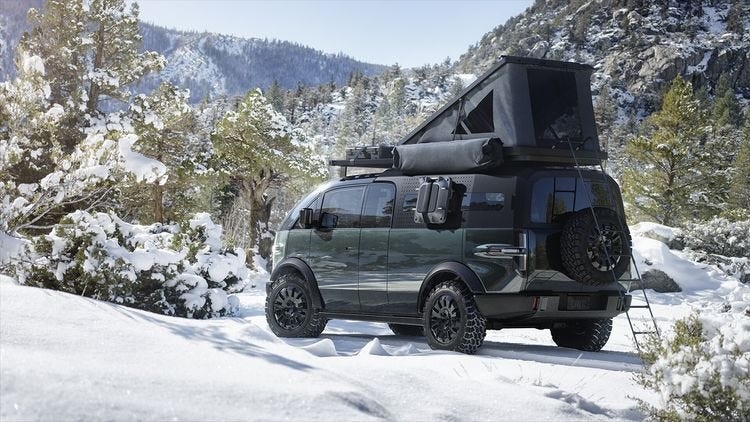The news of Canoo’s bankruptcy has rippled through the electric vehicle (EV) community, marking a somber moment for enthusiasts and industry watchers alike. For years, the promise of the Canoo Electric Vehicle, affectionately dubbed the “toaster” or “electric minibus” for its distinctive shape, held a unique appeal. As an automotive repair expert and content creator at keyfobx.com, I’ve followed Canoo’s journey closely, captivated by its innovative design and the potential it represented. While the detailed financial breakdown of Canoo’s demise is expertly covered by Steve Hanley, it’s the groundbreaking design of the Canoo electric vehicle that deserves a closer look and a heartfelt tribute.
Canoo dared to reimagine vehicle design, prioritizing functionality and user experience over conventional aesthetics. Richard Kim, Canoo’s design lead in 2020, articulated this vision perfectly, describing the Canoo electric vehicle as a “loft on wheels.” This wasn’t merely about creating another car; it was about rethinking the very essence of automotive design, focusing on the evolving needs of future users. This philosophy gave birth to some truly remarkable features that set the Canoo apart in the burgeoning EV landscape.
The Revolutionary Skateboard Platform of the Canoo EV
At the heart of the Canoo electric vehicle’s innovation lay its “skateboard” platform. This concept, championed by visionary Amory Lovins years prior, involves integrating the core components of the vehicle – batteries and motors – into a single, low-profile chassis. Canoo took this idea and ran with it, creating a modular foundation upon which various vehicle bodies could be easily mounted. This approach streamlined manufacturing and opened up unprecedented design flexibility.
Steer-by-Wire: A Bold Step Towards the Future of Driving
Canoo further distinguished itself with its pioneering adoption of “steer-by-wire” technology in their electric vehicles. This system eliminates the traditional mechanical linkage between the steering wheel and the wheels, replacing it with an electronic system. The benefits are manifold: weight reduction, enhanced responsiveness, and a smoother driving experience. Moreover, steer-by-wire unlocks significant design freedom within the cabin, paving the way for more versatile and user-centric interior layouts and advancing the possibilities for autonomous driving integration in future Canoo electric vehicle iterations.
Visibility and Practicality: Design Driven by User Needs
One of the most lauded aspects of the Canoo electric vehicle was its exceptional visibility. The low front window, a thoughtful design element, directly addressed pedestrian safety by improving the driver’s line of sight, particularly for objects close to the vehicle. This feature, coupled with an array of cameras, radars, and sensors, underscored Canoo’s commitment to safety and practicality in their electric vehicle design.
The Canoo Electric Pickup Truck: Reimagining Utility
Extending the versatility of their skateboard platform, Canoo ventured into the pickup truck segment with their electric pickup truck. This model echoed the design philosophy of the original Canoo van, prioritizing space efficiency and cargo capacity within a compact footprint. Drawing parallels to the classic Volkswagen pickup trucks of the past, the Canoo electric pickup truck offered a compelling blend of retro-inspired design and modern EV technology.
The Canoo pickup truck was engineered to maximize cargo space while maintaining a maneuverable size, boasting a substantial payload capacity comparable to its vintage Volkswagen counterpart. Its customizable rear compartment further enhanced its practicality, showcasing Canoo’s dedication to creating truly adaptable electric vehicles.
Designing from First Principles: The Legacy of Buckminster Fuller
Canoo’s design approach was deeply rooted in first principles thinking, reminiscent of Buckminster Fuller’s innovative Dymaxion Car. By challenging conventional automotive design norms and focusing on fundamental user needs, Canoo achieved remarkable results. Their electric vehicles offered exceptional interior space and functionality within a surprisingly compact exterior. The Canoo electric pickup truck, for instance, delivered a six-foot truck bed in a vehicle only marginally longer than a standard Subaru Impreza, a testament to their space-optimized design philosophy.
The Challenge of Radical Design and Market Acceptance
However, this radical departure from traditional automotive aesthetics also presented a significant hurdle for Canoo. In a market often swayed by familiar forms and established styles, the Canoo electric vehicle’s unconventional “toaster” shape was met with mixed reactions. This phenomenon, known as skeuomorphism, often leads consumers to favor designs that mimic familiar gas-powered vehicles, even in the EV space.
While some admired Canoo’s bold design language, others found it less appealing. Ultimately, market acceptance plays a crucial role in the success of any vehicle, and in Canoo’s case, the unique design, while innovative, may have contributed to their struggle for broader appeal.
A Fond Farewell to the Brave Little Toaster
Despite its unfortunate bankruptcy, the Canoo electric vehicle leaves behind a legacy of bold innovation and user-centric design. It dared to challenge conventions, rethink automotive fundamentals, and prioritize functionality in a way rarely seen in the industry. Whether or not the market was ready for its radical vision, the “brave little toaster” of a car pushed the boundaries of EV design and reminded us of the importance of thinking differently. The dream of the Canoo electric vehicle may have been cut short, but its design spirit and innovative ideas will undoubtedly continue to inspire future generations of automotive designers and EV enthusiasts.
